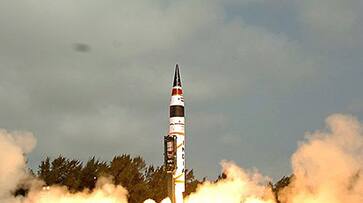Riding on a huge success wave over the last few months in relation to 30 months, India now plans to deploy nuclear-capable ballistic missile Agni-V this year in strategically important places
Bengaluru: Riding on a huge success wave over the last few months in relation to 30 months, India now plans to deploy nuclear-capable ballistic missile Agni-V this year in strategically important places, as per a report by The New Indian Express.
It is anybody’s guess that Agni-V will be a game changer for India.
What it means is very simple: The missile, which has a range of over 5000km, will be able to send shivers down the spine of many Chinese cities. And that includes Beijing as well.
With this missile inducted, India can respond to a Chinese nuclear attack with massive retaliation, as laid-out in the nuclear doctrine. Thus, the missile will play an important role in establishing the credibility of deterrence viz-à-viz China.
The New Indian Express also relied upon defence sources to say that the missile, which is undergoing its pre-induction trials, would be finally deployed at strategic locations as selected by the armed forces.
The canisterised Agni-V provides the necessary operational flexibility to the forces.
Canisterisation enables a missile to be kept in a state of readiness, makes camouflaging the missile easier and permits rapid launch.
Being placed on a road-mobile launcher, the missile can be moved from one location to another in times of heightened conflict to avoid detection by enemy satellites. This, in turn, increases its survivability in a preemptive counterforce strike.
Agni-V is a solid-fueled missile. Solid-fueled missiles offer the benefit of a quick response and longer storage life. Prearranging a liquid-fueled missile for launch, in comparison, takes more time.
Also, in case of non-use, liquid fuel must be drained out from the missile due to its highly corrosive nature and stored separately. Therefore, it is easy to store and transport a solid-fueled missile.
Last Updated Jan 5, 2021, 3:56 PM IST









![Salman Khan sets stage on fire for Anant Ambani, Radhika Merchant pre-wedding festivities [WATCH] ATG](https://static-gi.asianetnews.com/images/01hr1hh8y86gvb4kbqgnyhc0w0/whatsapp-image-2024-03-03-at-12-24-37-pm_100x60xt.jpg)
![Pregnant Deepika Padukone dances with Ranveer Singh at Anant Ambani, Radhika Merchant pre-wedding bash [WATCH] ATG](https://static-gi.asianetnews.com/images/01hr1ffyd3nzqzgm6ba0k87vr8/whatsapp-image-2024-03-03-at-11-45-35-am_100x60xt.jpg)


